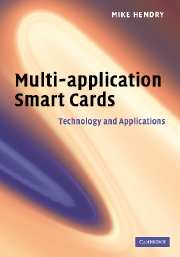Book contents
- Frontmatter
- Contents
- Foreword by Kevin Gillick
- Acknowledgements
- Part I Introduction
- Part II Technology
- 4 Biometrics
- 5 Security and cryptography
- 6 Card technology
- 7 Readers and terminals
- 8 Application selection: the ISO 7816 family
- 9 JavaCard and GlobalPlatform
- 10 Multos
- 11 Other operating systems
- 12 Card management systems
- Part III Business requirements
- Part IV Implementation
- Appendix A Glossary
- Appendix B Further reading
- Appendix C Standards
- Index
- References
6 - Card technology
from Part II - Technology
Published online by Cambridge University Press: 11 August 2009
- Frontmatter
- Contents
- Foreword by Kevin Gillick
- Acknowledgements
- Part I Introduction
- Part II Technology
- 4 Biometrics
- 5 Security and cryptography
- 6 Card technology
- 7 Readers and terminals
- 8 Application selection: the ISO 7816 family
- 9 JavaCard and GlobalPlatform
- 10 Multos
- 11 Other operating systems
- 12 Card management systems
- Part III Business requirements
- Part IV Implementation
- Appendix A Glossary
- Appendix B Further reading
- Appendix C Standards
- Index
- References
Summary
This chapter picks up the story from Chapter 3 and looks at advances and variants in chip and card technology, particularly those that affect multi-application cards.
Microcontrollers
Architecture
The microcontroller chip is at the heart of smart-card technology; as we saw in Figure 1.2 an increasing proportion of all smart-card chips use one.
As in all computing, more advanced operating systems and applications are demanding more power from the processor. But while microprocessors for mainstream computing are able to satisfy the demand for more power by increasing the number of transistors packed onto the chip, and hence the heat generated, smart-card chips are limited in both the area of the chip (25 mm2 is normally considered the limit for reliability) and the amount of heat that can be dissipated.
A growing number of chips, therefore, make use of reduced instruction-set computing (RISC) cores, which give faster processing for a given power input. Separating the cryptography into its own processor can also help, and it is also more efficient if the input–output is handled by its own processor. Longer word sizes (32 bit words are now the norm in mainstream computers, and 64 bits quite common) are less beneficial in smart cards, and a 32 bit processor does not necessarily give a better speed–power ratio than 16 bits.
Cards can be tailored to the specific applications they will run: Multos cards have for some time been tailored to running the specific code that this operating system generates, and some processors are now optimised to run Java byte code directly.
- Type
- Chapter
- Information
- Multi-application Smart CardsTechnology and Applications, pp. 50 - 58Publisher: Cambridge University PressPrint publication year: 2007



